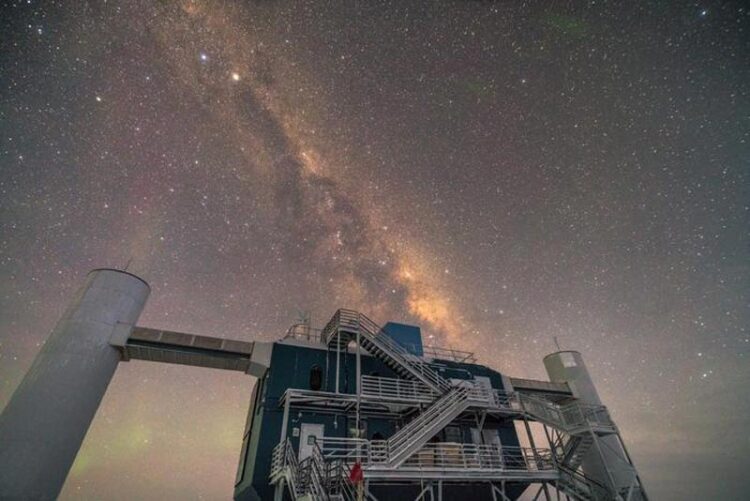The first neutrino image of our galaxy

IceCube at the South pole with the Milky Way in the background.
Photo: Martin Wolf, IceCube NSF
For the first time, researchers have produced an image of the Milky Way using neutrinos, which were observed with the IceCube telescope in the Antarctic ice. The neutrino image suggests that cosmic ray interactions are more intense in the center of our galaxy than once thought. The results are published in an article in the journal Science.
For ages, the view of our Milky Way galaxy has inspired awe, visible with the naked eye as a hazy band of stars that stretches across the sky. Now IceCube researchers are able to see the Milky Way using neutrinos – tiny, ghostlike particles that fly freely through matter and space.
The neutrinos were detected using the IceCube Neutrino Observatory, a neutrino telescope built at the South Pole and monitoring 1 billion tons of the Antarctic ice for the rare neutrino interactions. Members of the IceCube Collaboration at Stockholm University and Uppsala University have been involved in the analysis of the data acquired during ten years of observations and in the interpretation of the results.
“Seeing our galaxy with neutrinos is something that we dreamed of, but which seemed out of reach for our project for many years to come,” says Chad Finley, associate professor at Stockholm University and one of the IceCube team members who worked closely on the paper. “What made this result possible today is the revolution in Machine Learning, allowing us to explore much deeper into our data than before.”
During the last century, astronomers began to study the Milky Way in all wavelengths of light, from radio waves to gamma rays. High-energy gamma rays in our galaxy are believed to be created mainly by the interaction of cosmic rays, high-energy protons and nuclei, with galactic gas and dust. This process should produce neutrinos as well. However, large uncertainties about the intensity of cosmic ray interactions in different parts of our galaxy made predictions for neutrinos a challenge.
The analysis method used for the latest results was originally developed in 2017 at Stockholm University by Jonathan Dumm, a postdoctoral researcher at the Oskar Klein Centre. “Jon realized that if the upper range of these neutrino predictions were correct, they might have been faintly detectable in the IceCube data we had at the time,” says Chad Finley.
To really map out the neutrino contours of the Milky Way, however, it was expected that many more years of data-taking would be needed. While the IceCube Observatory records billions of events each year, only a very tiny fraction (one in one-hundred million recorded events) is due to neutrinos from space. Identifying these neutrino events is a difficult computational task. Thanks to the development of new computing techniques called Deep Neural Networks, it has become possible to identify these neutrino events with 20 times higher efficiency than before.
“High-energy neutrinos provide us with a wonderful new tool for studying the Milky Way. The next step is to identify the neutrino sources, potentially the sites for galactic cosmic ray acceleration” says Olga Botner, senior professor at Uppsala University. “If realized, the planned IceCube-Gen2 would enable a deeper yet exploration of the galactic plane, allowing us to distinguish between various source distributions and models for cosmic ray propagation.”
More information
The article “Observation of High-Energy Neutrinos from the Galactic Plane” is published in the scientific journal Science.
Facts on IceCube
The IceCube Collaboration is an international group of over 350 scientists based at 58 institutions around the world. Stockholm University and Uppsala University are two of the founding members of the IceCube project. The IceCube Neutrino Observatory is supported by the National Science Foundation, as well as the Swedish Research Council (Vetenskapsrådet) and national funding agencies in other countries. See https://icecube.wisc.edu/
Contact
Chad Finley, associate professor at the Department of Physics, Stockholm University, cfinley@fysik.su.se, Phone +46-702295361
Olga Botner, professor at the Department of Physics and Astronomy, Uppsala University, olga.botner@physics.uu.se, Phone +46-184713876
Journal: Science
Article Title: Observation of High-Energy Neutrinos from the Galactic Plane
Article Publication Date: 29-Jun-2023
Media Contact
Per Larsson
Stockholm University
per.larsson@su.se
Office: 0046-816-4464
All latest news from the category: Physics and Astronomy
This area deals with the fundamental laws and building blocks of nature and how they interact, the properties and the behavior of matter, and research into space and time and their structures.
innovations-report provides in-depth reports and articles on subjects such as astrophysics, laser technologies, nuclear, quantum, particle and solid-state physics, nanotechnologies, planetary research and findings (Mars, Venus) and developments related to the Hubble Telescope.
Newest articles

Sea slugs inspire highly stretchable biomedical sensor
USC Viterbi School of Engineering researcher Hangbo Zhao presents findings on highly stretchable and customizable microneedles for application in fields including neuroscience, tissue engineering, and wearable bioelectronics. The revolution in…

Twisting and binding matter waves with photons in a cavity
Precisely measuring the energy states of individual atoms has been a historical challenge for physicists due to atomic recoil. When an atom interacts with a photon, the atom “recoils” in…

Nanotubes, nanoparticles, and antibodies detect tiny amounts of fentanyl
New sensor is six orders of magnitude more sensitive than the next best thing. A research team at Pitt led by Alexander Star, a chemistry professor in the Kenneth P. Dietrich…





















